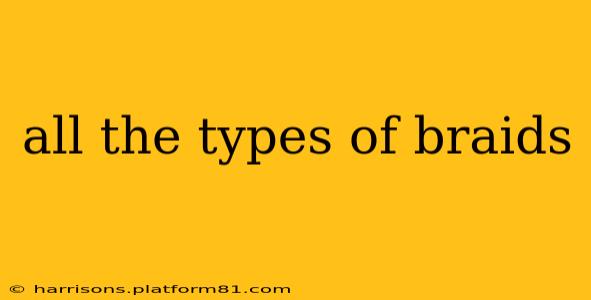Braiding hair is an ancient art form, transcending cultures and time. From simple three-strand braids to intricate cornrows, the possibilities are endless. This comprehensive guide explores the diverse world of braids, categorizing them for easier understanding and appreciation. We'll delve into various styles, techniques, and considerations for choosing the perfect braid for your hair type and desired look.
What are the Different Types of Braids?
This question is best answered by breaking down braids into categories based on their structure and technique. While there are countless variations, we'll focus on the major types:
1. Three-Strand Braids: The Foundation
The classic three-strand braid is the cornerstone of many more complex styles. It's simple to learn but offers incredible versatility. Variations include:
- Dutch Braid: This braid is similar to a French braid, but the strands are crossed underneath instead of over, creating a raised braid that appears to sit on top of the hair.
- French Braid: This braid begins at the crown of the head and incorporates more hair as you braid downwards, creating a seamless, elegant style.
- English Braid (or Overhand Braid): This is the most basic three-strand braid, with strands consistently crossed over each other.
- Reverse Braid (or Inside-Out Braid): This is similar to a standard braid but the strands are tucked under instead of over.
2. Cornrows (or Canerows): Close to the Scalp
Cornrows are intricate braids that lie flat against the scalp. They are often created using a specific technique, where the braid is tightly interwoven with sections of hair added along the way. They're known for their durability and ability to protect hair.
3. Fishtail Braids: A Unique Pattern
This braid utilizes only two strands of hair, creating a distinctive, intricate pattern reminiscent of a fish’s tail. It offers a bohemian, romantic aesthetic and looks stunning on long hair.
4. Box Braids: Versatile and Protective
Box braids are a popular protective style involving sectioning the hair into squares and braiding extensions into each section. The braids can be thick or thin, long or short, and offer great flexibility in styling.
5. Flat Twists: A Braid Alternative
While not technically braids, flat twists create a similar look by twisting two strands of hair together. They are often used as a foundation for more elaborate styles and are less tensioning on the hair than some braids.
6. Rope Braids: Two-Strand Elegance
Rope braids involve twisting two strands of hair around each other to create a textured, rope-like braid. It's a relatively easy technique and produces a stylish result.
7. Ladder Braid: Adding a Unique Touch
This braid is a visual delight, created by picking up sections of hair from the sides of the head and adding them to the braid in a ladder-like pattern. It’s best suited for medium to long hair.
What are some other braiding styles?
Beyond these core types, countless variations and combinations exist. Styles are often named after their appearance, cultural origin, or the braider's unique creation. Some additional styles include:
- Pull-Through Braid: This style creates a unique cascading effect with sections of hair pulled through each other.
- Milkmaid Braid: This style involves braiding hair around the head, resembling the braids worn by milkmaids.
- Halo Braid: A variation of the milkmaid braid that encircles the head like a halo.
- Dutch Waterfall Braid: A visually stunning braid where sections of hair are released to flow down the sides, resembling a waterfall.
- Crown Braid: Similar to halo braid but tighter and often interwoven with other braids.
How do I choose the right braid for my hair?
The best braid for you depends on several factors:
- Hair length: Shorter hair might only be suitable for certain styles like cornrows or simple three-strand braids.
- Hair texture: Thick, coarse hair may benefit from looser braids to prevent tension, while finer hair might look better with tighter braids.
- Skill level: Some braids are more challenging than others. Start with easier styles and gradually work towards more complex ones.
- Desired look: Consider the overall style you want to achieve – romantic, edgy, sleek, or bohemian.
Braiding opens a world of creative expression. With practice and exploration, you can master various techniques and find your signature braid style. Experiment, have fun, and enjoy the versatility this ancient hair art offers!
